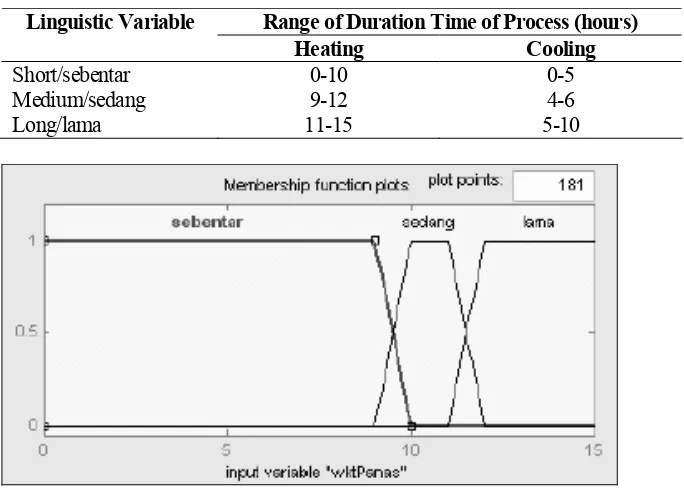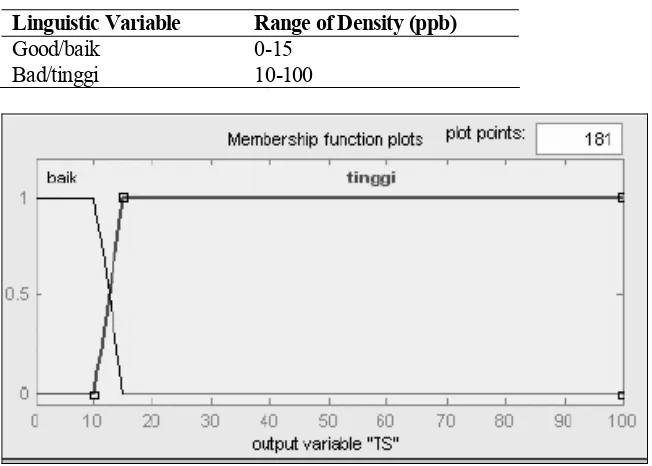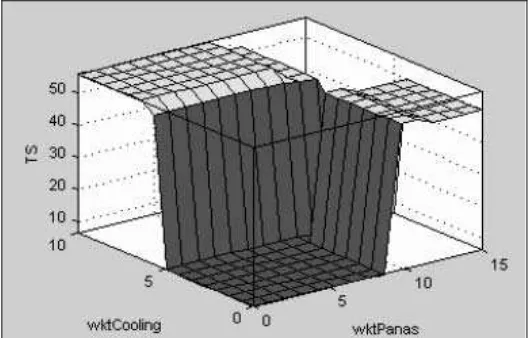FUZZY INFERENCE SYSTEM MODELING FOR BED ACTIVE
CARBON RE-GENERATION PROCESS
(CO
2Gas Factory Case)
I Nyoman Sutapa and Iwan Halim Sahputra, Faculty of Industrial Technology, Industrial Engineering Department,
Petra Christian University
Email: [email protected]; [email protected]
M. D. Kurniawati and S. Febriana
Alumnus of Industrial Engineering Department, Faculty of Industrial Technology, Petra Christian University
ABSTRACT
Bed active carbon is one of the most important materials that had great impact in determining level of impurities in production of CO2 gas. In this particular factory case, there is unavailability of standard duration time of heating and cooling and steam flow rate for the re-generation process of bed active carbon. The paper discusses the fuzzy inference system for modeling of re-generation process of bed active carbon to find the optimum setting parameter. The fuzzy inference system was build using real historical daily processing data. After validation process, surface plot analysis was performed to find the optimum setting. The result of re-generation parameter setting is 9-10 hours of heating process, 4.66-5.32 hours of cooling process, and 1500-2500 kg/hr of steam flow rate.
Keywords: fuzzy inference system, bed active carbon, re-generation process.
1. INTRODUCTION
There is a requirement for CO2 gas production factory to fulfill the Standard of Health
Department of Indonesia regarding the quality of their production for food industry. One of the requirements is the maximum impurity of the gas, which the most important substances are water and sulfur.
In CO2 gas production process, bed active carbon is used as absorber for the impurities
(Lenntech, 2005). After being used for several hours in production process, or it is known as running process, it must be re-generated to recover its ability to adsorb the impurities. This process is known as re-generation.
In this case, the particular CO2 gas factory installs thermal re-generation (Lenntech, 2005).
When one bed is regenerated, the other bed remains active for adsorption. The re-generation process parameters that influenced the ability of bed active carbon to adsorb the impurities are duration time of heating and cooling and steam flow rate. The optimal parameters setting for re-generation process will increase the ability of bed active carbon to adsorb the impurities. This paper is based on the work done before by Kurniawati and Febriana (1995).
2. PROBLEM FORMULATION
process were used as input for fuzzy inference system model and the density of water (ppm) and sulphur (ppb) impurities in CO2 gas as the output of model.
3. PROBLEM SOLUTION
The Mamdani method was used to build the fuzzy inference model for the re-generation process (Jang, Sun, and Mizutani; 1995). This model has three inputs and two outputs. The model was build using Matlab 7 and Fuzzy Logic Toolbox software (Jang, 1995). This model is shown in Figure 1.
Figure 1. Fuzzy Inference System Model
3.1 Membership Function for Input Variables
Three linguistic variables were defined for duration of heating and cooling process, as listed in Table 1. Figures 2 and 3 shows the membership function for these two input variables.
Table 1. Linguistic Variable for Heating and Cooling
Range of Duration Time of Process (hours) Linguistic Variable
Heating Cooling
Short/sebentar 0-10 0-5
Medium/sedang 9-12 4-6
Long/lama 11-15 5-10
Figure 3. Membership Function for Cooling Process
Two linguistic variables were defined for steam flow rate, as listed in Table 2. Figure 4 shows the membership function for this output.
Table 2. Linguistic Variable for Steam Flow Rate
Linguistic Variable Range of Rate (kg/hr)
Low/sedikit 900-2500 High/banyak 1500-3300
Figure 4. Membership Function for Steam Flow Rate
3.2 Membership Function for Output Variables
Table 3. Linguistic Variable for Sulfur Density
Linguistic Variable Range of Density (ppb)
Good/baik 0-15 Bad/tinggi 10-100
Figure 5. Membership Function for Sulfur Density
Three linguistic variables were defined for the density of water, as listed in Table 4. Figure 6 shows the membership function for this output variable.
Table 4. Linguistic Variable for Water Density
Linguistic Variable Range of Density (ppm)
Good/baik 0-25 Medium/sedang 15-45 Bad/tinggi 35-100
3.3 Fuzzy Rule
Interview with factory engineer and historical daily data from on September 2003 were used to define the fuzzy rule for this model. Each value from historical data was classified according to the linguistic variable defined. For output data variable, modulus value was taken. The ‘and’ rule was defined as: If (input1) and (input2) and (input3) then (output1) and (output2).
Where input1 is heating process duration time, input2 is cooling process duration time, and input3 is steam flow rate. Output1 is density of sulfur and output2 is density of water. Fuzzy rule were defined as listed in Table 5 and the rule viewer can be seen in Figure 7.
Figure 7. Rule Viewer of the Model
Tabel 5. Fuzzy Rules for the Model
No Input1 Input2 Input3 Output1 Output2
Tabel 5. Fuzzy Rules for the Model (lanjutan)
No Input1 Input2 Input3 Output1 Output2
13 Medium Medium Low Good Medium
Centroid method was used as defuzzification method because it is suitable to the process condition. A small change in one of input variable will change the output condition.
3.5 Model Validation
Historical daily data on August 2003 were used as input for model. The output from the model was compared to actual output from historical data using two-sample-t test method (Bhattacharya and Johnson, 1997). Minitab 13 software was used to do the test. Test result shown that the model is significantly valid for representation of the real process, using α=0.05.
3.6 Optimal Parameter Setting for Re-generation Process
Using the model as representative of the real condition, the optimal parameter setting was found by analysis of surface viewer of Matlab software. Figure 8 and 9 show some surface plots for several input and output variables.
Figure 9. Surface Plot for Heating and Cooling Duration Time related to Density of Water
Using all of surface plots, the intersection area of input variable was defined to produce output values that fulfill the requirement of Health Department standard. Standard of impurity of sulfur is 0-15 ppb and for water is 0-15 ppm. The result is shown in Table 6.
Table 6. Optimal Parameter Setting for Re-generation
Input Variable Range of Optimum Value
Heating duration time 9-10 hours Cooling duration time 4.66 - 5.32 hours
Steam flow rate 1500 - 2500 kg/hour
4. CONCLUSION
Fuzzy Inference System has been used for modeling of re-generation process of bed active carbon. The model was a valid representation of the real condition according to the two-sample-t test result using α=0.05. Re-generation parameter setting range obtained is 9-10 hours of heating process, 4.66-5.32 hours of cooling process, and 1500-2500 kg/hr of steam flow rate. Future research needed to investigate other re-generation process parameters that affect the adsorption quality of bed active carbon performance.
REFERENCES
Bhattacharya, G.K. and R.A. Johnson, 1997. Statistical Concepts and Methods, John Wiley & Sons Inc.
Jang, R., 1995. Fuzzy Logic Toolbox Four Use with Matlab, The MathWorks Inc.
Lenntech, inc., 2005. Regenerative adsorption with active carbon, available at:http://www. lenntech.com/Air-purification/Gas-purification-techniques/Regenerative-adsorption-active-carbon.htm
Lenntech, inc., 2005. Regenerative adsorption, available at: http://www.lenntech.com/Air-purification/Gas-purification-techniques/regeneraritive-adsorbtion.htm





